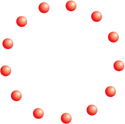Rydberg rings
A wide variety of collective excitations and behaviors resulting from strong correlations can be studied with the use of ultracold atoms placed into optical lattice traps. In many cases, these experiments are carried out with the atoms in their ground states; however, atoms in highly excited states offer richer opportunities for controlling and studying such phenomena. Rydberg atoms, where the electrons are excited to very high quantum states and occupy spatially extended orbits, are particularly interesting in this regard. In an article in Physical Review A, Beatriz Olmos, Rosario González-Férez, and Igor Lesanovsky, from the University of Granada, Spain, and the University of Nottingham, UK, expand on earlier work [1] in which they theoretically studied Rydberg atoms in a ring lattice to examine many-particle entangled states.
The authors calculate the properties of a ring of bosonic atoms confined to a deep ring-shaped lattice with spacing much greater than the extent of the localized atomic wave function. These atoms are two-state entities where the excited state is a Rydberg level. A laser field is then used to couple the ground and excited states with a frequency slightly detuned from resonance. Olmos et al. find that this coupled system behaves like a chain of spinless fermions with dynamical properties like that of the model, and go on to explain how such states might be experimentally accessible. – David Voss
[1] B. Olmos, R. González-Férez, and I. Lesanovsky, Phys. Rev. Lett. 103, 185302 (2009).





